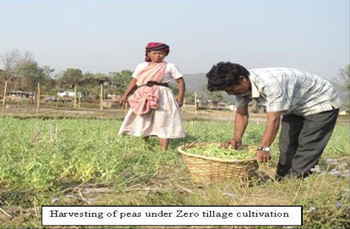The Nongthymmai village in Ribhoi district of Meghalaya under the subtropical hill agro-climatic zone is a climatically vulnerable area mostly affected by acute scarcity of water during rabi season. The main occupation of the population rests on agriculture and allied activities. Majority of the farmers grow rice, maize, soybean, tomato, brinjal, ginger and turmeric etc. but with a low cropping intensity of about 110-120%. Generally, mono-cropping system of rice cultivation is practised. Instead of taking up second crop after kharif rice, farmers leave rice field fallow during rabi season mainly owing to lack of irrigation facilities. Therefore, in order to enhance the cropping intensity, ICAR Research Complex for NEH Region, Meghalaya introduced the zero tillage technology in Nongthymmai village under NICRA (Technology Demonstration Component) Project.

Initially some capacity building programmes were organised on zero tillage technologyin which skill based knowledge on the technology was imparted to the farmers. The technology was first adopted by the progressive farmer Mr. Stephan Shadap during 2011-12. Along with him four other farmers also took up the zero tillage method of cultivation on garden pea covering around 1.5 ha. ICAR provided the critical inputs like seeds, fertilizer, FYM etc. for successful demonstration on the technology. Thereafter, regular monitoring of the demonstration programme was made by scientists and project staff through frequent village visits and timely advisory services.
Effect of the technology
The demonstration was conducted in the village continuously for three consecutive years from 2011-12 to 2013-14. Details of number of farmers involved, area covered, average yield, income etc. are summarised in the table.
Table : Economic return from different cropping sequences rice –fallow(monocropping) VS rice-pea (zero tillage)
| Year
|
No. of farmers |
Area covered |
Cropping sequence |
Av.yield |
Gross |
Gross |
Net Income (Rs./ha) |
B:C ratio |
|
|
2011-12 |
- |
- |
Rice-fallow |
36.85 |
19,600 |
36,850 |
17,250 |
1.88 |
|
|
5 |
1.5 ha |
Rice- Pea |
Rice |
35.00 |
18,500 |
35,000 |
16,500 |
1.89 |
|
|
Pea |
29.25 |
30,500 |
61, 200 |
30,700 |
2.01 |
||||
|
Rice+Pea |
64.25 |
49,000 |
96,200 |
47,200 |
1.96 |
||||
|
2012-13 |
- |
- |
Rice-fallow |
37.25 |
19,250 |
37,250 |
18,000 |
1.94 |
|
|
10 |
4.5 ha |
Rice- Pea |
|
38.00 |
20,000 |
38,000 |
18,000 |
2.00 |
|
|
Pea |
31.65 |
31,500 |
76,125 |
44,625 |
2.42 |
||||
|
Rice+Pea |
69.65 |
51,500 |
1,14,125 |
62,625 |
2.22 |
||||
|
2013-14 |
- |
- |
Rice-fallow |
38.15 |
19,850 |
38,150 |
18,350 |
1.92 |
|
|
25 |
7.25 ha |
Rice- Pea |
|
38.80 |
20,000 |
38,800 |
18,800 |
1.94 |
|
|
Pea |
32.75 |
33,250 |
81,900 |
48,650 |
2.46 |
||||
|
Rice+Pea |
71.55 |
53,250 |
1,20,700 |
67,450 |
2.27 |
||||
Horizontal spread of the technology
The successful demonstration of this climate resilient was realised by following the principles of “learning by doing” and “seeing is believing”. After the successful intervention of this technology, farmers started growing rabi pulses like pea successfully after kharif paddy instead of keeping the rice field fallow during rabi season. The impressive performance of the technology awakened the farmers, farm women, rural youths of the village as well as neighbouring villages namely Klew, Nongpyrdet, Mawnohsynrum and Mawkyrdep to adopt this resilient technology for second crop after paddy as it helps to increase the cropping intensity and elevate net income. Moreover, this technology was also found to be a better reconciliation under the climatic stress condition.
(Source: Technology Demonstration Component of NICRA Project, ICAR Research Complex for NEH Region, Meghalaya)







फेसबुक पर लाइक करें
यूट्यूब पर सदस्यता लें
X पर फॉलो करना X
इंस्टाग्राम पर लाइक करें